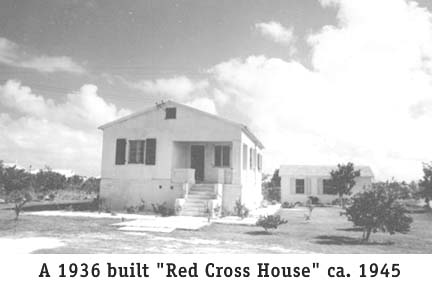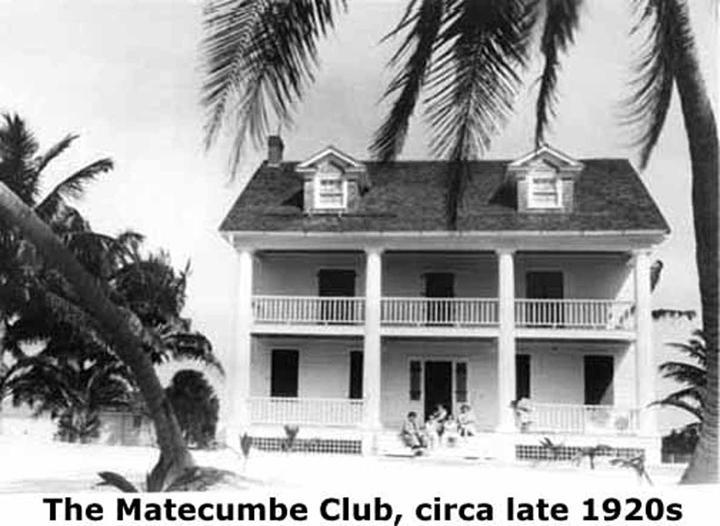|
MATECUMBE KEY By Jerry Wilkinson |
 |
|
MATECUMBE KEY By Jerry Wilkinson |
 |
|
In 1838, Richard H. Russell (1850, farmer, 35) and family arrived on
Key
Vaca [Marathon]. In the mid-1850s he and his wife Mary Ann [Roberts]
moved
to Upper Matecumbe Key. On the northeast end of the Key, Mary Ann
homesteaded
162.58 acres in 1882 and Richard homesteaded 31.09 acres in 1885. The
Russells,
with their daughter, three sons, granddaughter and three grandsons,
eventually
became the largest family in the Upper Keys. The cluster of homes and
family
cemetery has been referred to as "Russellville," or the "east-end." In 1870, Richard Pinder (farmer, 48), wife Sarah and their four children farmed Indian Key and surrounding islands. His oldest son, Cephas, his wife Charlotte and two children, plus two other Pinder families were also farmers residing on Indian Key. Later Richard and sons, Cephas (farmer, 27) and Adolphus (farmer, 22), moved to Upper Matecumbe Key and homesteaded the center portion of the island. Richard homesteaded 130.96 acres in 1883, Cephas 148.9 acres in 1882 and 1892, and Adolphus 149.92 acres in 1883. State records indicate that in 1907, William H. Parker (1910, farmer, 55) received a land patent for 171.41 acres at the southwest end of the island. This area was known as Parkerville or "The West End." Russellville, Pinderville, and the later Parkerville, comprised what was known in earlier days as "Matecumbe." A note on the names Russellville and Parkerville. These names may have been given by journalists as I have spoken with some family members who had never heard of these names. William H. Parker traveled from Harbor Island, Bahamas to Key West where he married Amy Cash. They moved first to Plantation Key and then to the lower part of Upper Matecumbe, where they started their large family plus homesteaded in the 1890s. One of the Parker children, Edney Parker, married Edna Pinder, granddaughter of Richard Pinder. Edney and Edna had 12 children - five sons and seven daughters. The Parker cluster of homes on Upper Matecumbe Key was appropriately known as Parkerville. The Parkers became a part of the early settlement on Upper Matecumbe, along with the aforementioned Russells and Pinders. The Parkers' arrival prompted the Russells and Pinders to move the church building south to facilitate better use by the three families. Matecumbe, as it was called then, became a family community under the Russells, Pinders and Parkers, but the railroad changed the character of another Keys community. The large homesteads split into smaller units during the Flagler era from 1905 to 1935. The islands became two halves separated lengthwise by the railroad. The Russells, Pinders and Parkers sold portions of land to newcomers like the Churchs, LaBranchs, Luckenbacks, Howells, Peacocks, Cothrons, Careys, etc. F.E.C. engineer William J. Krome surveyed various potential routes for the Overseas Extension from 1902 to 1904. In 1903, he filed a homestead claim at what is now Krome Avenue and Avocado Drive in Homestead. Krome, a bachelor, continued working for the railroad under Joseph Meredith, but began taking time off to buy more land and develop groves in Homestead. One of the pieces of land he purchased in 1907 was on Upper Matecumbe Key. On this land, Krome plotted the Townsite of Islamorada with 22 lots, hence the name Islamorada came into existence. Mrs. William J. Krome wrote to Mal Flanders on May 10, 1965, "I was not a member of the family at that time [They married in 1910.] and had no part in the selection of the name, but Mr. Krome told me that it was derived from the Spanish isla (island) and morada, meaning home." In the letter she went on to write that her husband paid $49 per acre for 15 acres from John H. and James W. Russell. Anyway, this was one of the first indications of family homesites on the bay side. Until then the majority lived on the ocean side to take advantage of the generally onshore breezes. Up until the advent of the railroad, families usually lived on the ocean side as there was a better breeze, access to ocean transportation and fewer mosquitoes. In 1908, the first Islamorada post office was opened. The railroad depot was a full service depot complete with telegraph, railway express and waiting room. Engineering acquaintances of Krome began to build homes on the bayside and the community of Islamorada was born. With time all of Upper Matecumbe became known as "Islamorada." After Hurricane Donna in 1960, the name Matecumbe appears to have fallen into disuse. Like Tavernier, the exact derivation of the names Matecumbe, Whale Harbor, Islamorada and many others will remain the subject of much discussion. Mrs. Krome of Homestead had a quite extensive collection of photos and clippings. The following article was photocopied from her scrapbook and is repeated below with spelling as it appeared. It was a clipped article and had a handwritten date of May 7, 1907, but the source was not identified. The columns were narrow as from a newspaper. Mrs. Krome also had the "Map of the Townsite of ISLAMORADA" on "Upper Matecumbe Key," which had a "Dedicatory Note" certifying that Wm. J. Krome dedicated certain portions for public use. It was signed/dated Jan. 3, 1907. The public park and the bay front street were given to the private property owners in 1956 and 1948 respectively. William Krome married Isabel Greenwood Burns in 1910 and made their principal home in Homestead. Krome had become the F.E.C. Chief Construction Engineer in 1909 after the death of Meredith. Krome continued with the F.E.C. until 1919. The Kromes had four children; Mary Elizabeth (1912), William (1914), Bob (1916) and Jack (1918).
Matecumbe, often spelled Matacumbe in earlier days, alm Most of the settlement of Matecumbe remained on the ocean side. It encompassed from about where the Cheeca Lodge is located and to the south end of the island. Sand had built up along the beach, so 8 to 10 feet of ground elevation was easily found. The 1935 hurricane spread the sand around more or less as one finds it today. As a footnote, Charles "Prof" Albury moved up from Key Vaca to join Ferran Pinder in teaching at a rock-built schoolhouse next to the Matecumbe Methodist Church located on the sandy Atlantic beach. Later, Prof taught at Tavernier, then he and Ferran taught at Coral Shores High School. One of the more famous places, also destroyed by the 1935 hurricane,
was a private fishing club. A biography of Herbert Parsons Gleason and
his brother George D. Gleason, both shoe manufacturers, were members of
the ... Matecumbe CLub on one of the Florida Keys...." George
Gleason's, also named George, grandson lives at Ocean Reef has
papers nameing it the Matecumb Club. the 1935 hurricane,
was a private fishing club. A biography of Herbert Parsons Gleason and
his brother George D. Gleason, both shoe manufacturers, were members of
the ... Matecumbe CLub on one of the Florida Keys...." George
Gleason's, also named George, grandson lives at Ocean Reef has
papers nameing it the Matecumb Club.Over time three other names have evolved: Islamorada Fishing Club, 2) Matecumbe Fishing Club and 3) The Millionaires Club. Regardless, this exclusive club was built in the 1920s originally by eleven members of the New York Cotton Exchange and its membership limited to 11. Some of these members built individual homes in the area as opposed to living in the club itself. In fact a street was named after one of the club's presidents, a Mr. Johnson. Bertram Pinder, one of the descendants of the original Pinder family, was the caretaker for 12 years. The sidings at the Islamorada railroad water tower were supposedly used for the parking of guest's private railroad cars. Another famous place was the Caribbee Colony built by George Merrick, who developed Coral Gables. It had a restaurant, cottages, pier, dance hall, and more. Merrick had guests brought down daily in train cars with a quota of 500. His South Seas Special left the F.E.C. Miami Royal Palm Park Station daily at 9:00 A.M. and returned at 7:00 P.M. The resort was managed by the Dumas family and the advertisements that I have show it as the Dumas Caribbee Colony. The 1935 hurricane destroyed the Caribbee Colony. The La Siesta Resort is presently at the location. The Matecumbe Club and the Caribbee Club were totally destroyed by the 1935 Hurricane. With the coming of the first overseas highway (1928), more resorts appeared in the Keys, such as the Matecumbe Hotel known then as the Russell Arms Hotel. Doddridge and Burnell Russell of Key West built the hotel. These resorts on Matecumbe, along with the Long Key Fishing Camp, Driiftwood Lodge at Tavernier and the Key Largo Angler's Club, became the principal tourist sites in the Upper Keys. For reference, the 1920 census revealed Matecumbe with 180 residents, Marathon with 100, Tavernier with 91, and Rock Harbor with 131 (At that time Rock Harbor was all of the island of Key Largo north of Tavernier) respectively. The 1928 business brochure listed Islamorada and Matecumbe separately. In Islamorada were: Florida Fish and Lobster Co., Capt. R. H. Russell, Motlow's Grocery, Russell's Marine Gas Station, Islamorada Fishing Camp and Ocean View Cafe. In Matecumbe were: Matecumbe Boat Works, Hotel Matecumbe, Rock House Fishing Lodge. The 1951 telephone directory listed all the Middle/Upper Keys as Marathon, Matecumbe and Key Largo. The 1935 hurricane struck Upper Matecumbe Key hard being just to the right of eye's path. Four seriously damaged but recognizable structures remained standing. They were O. D. Kings' Rustic Inn, the Methodist parsonage, The Hotel Matecumbe and Leo Johnson's house. The coral-rock post office was also recognizable by those who knew it before. Therefore, almost nothing was left standing and there was a great toll of human life, but the determined citizens were not to be denied. Houses, a school, post office and the church were rebuilt. This was "home." The
Methodist parsonage and the Matecumbe Hotel were later destroyed. Leo
Johnson
rebuilt his home and it stands today on De Leon Avenue. The Rustic Inn
evolved
into the Green Turtle Inn. From the Florida Keys Weekly News
dated
October 25, 1947 we read, " Sid and Roxy Siderius who previously
operated
the Seabreeze Bar and Restaurant will have the formal opening of the
Green
Turtle Inn at Islamorada, Saturday evening, October 25th. Free drinks
and
eats from 7 to 9. The public is cordially invited."
Upper Matecumbe has the largest concentration (19) of what are known as
"Red Cross" or “Conch Houses” houses. There are 18 concrete
houses, two of wood, two business buildings
with the cooperation of the Red Cross and the Florida
Emergency Relief Administration (FERA). Built especially strong, they
provided
habitat for Keys families who lost their homes in the 1935 hurricane.
Some,
especially women and children, were relocated and subsidized by the Red
Cross until they could return to a completed house. At first returning
citizens lived in a tent on the beach. As time passed citizens built
temporary
houses until their Red Cross house could be finished. Many of these Red
Cross houses remain; however, most have been modernized. A photo of one
of these houses is shown at the top of this web page.
One wooden building was built by Eddie Sweeting using materials
provided by FERA and he provided all the labor. It was a two story
building,
shown at the right, in which they lived in the upper floor and the
lower floor was leased
to the School Board. The previously shown
coral rock school on the beach was totally destroyed and a school was
desperately needed as residents were returning. The federal government also subsidized the building of two wooden structures to replace businesses destroyed. Material only was provided to Eddy Sweeting to rebuild his grocery store as he wanted a two-story structure. One private business did survive the hurricane -known by some as the Rustic Inn and by others as King's filling station. Berlin Felton had moved from Rock Harbor in the early 1930s and built it as a place to sell drinks, some say of the hard kind. At some time it was sold to O. D. King, who operated it as a gasoline filling station facing the old highway at the time of the 1935 hurricane. The hurricane twisted it around, however it was reparable. Later, Sid and Roxie Siderius acquired it and changed its name to The Green Turtle Inn, the name used today by a totally new building - same location. Sid and Roxie also operated a fish house and cannery up the highway on the bayside. The cannery had wooden pens (turtle kraals) along the shore. If I am not mistaken, they lived upstairs over the cannery. Don Wollard repaired/built boats just north of the fish house.
While the first floor of Eddy Sweeting's rebuilt store was used Islamorada is also the home of The Florida Keys Memorial that memorializes WW I veterans and civilians killed in the 1935 hurricane. The Memorial was also constructed by the WPA on piece of property acquired for the aforementioned hurricane refuge school; therefore, are across the highway from each other at about MM 81.6. For the history of the Memorial please Click Here. After returning from military service in WW II, Bernard Russell spearheaded a drive to establish a volunteer fire department. Their first truck was a 1942 Chevrolet Crash Truck obtained from Opa-Locka in the Miami area.
As in all the Keys, the advent of electricity and fresh water in 1942
brought
new businesses to the Islamorada area. The Olney Inn is an example. The
Richardson family of the Vicks Chemical Company engaged Alonzo Cothron
to build an exclusive residence from 1937 to 1938. It was later sold to
the Stratton family, who in turn sold it to Al Mills who operated it as
the Casa Islamorado, a hotel, bar and restaurant in 1949. Subsequently
Clara May Downey The October 25, 1947 issue of the Florida Keys Weekly News carried a front page article announcing, "Sid and Roxy Siderius who previously operated the Seabreeze Bar and Restaurant will have the formal opening of the Green Turtle Inn at Islamorada, Saturday evening, October 25th." In 1960, Hurricane Donna destroyed the Olney Inn and in 1961, Mrs. Downey sold the property. The new owners, Cynthia Twitchell, , and husband Carl, an A & P Grocery chain heir, rebuilt the resort and named it the Cheeca Lodge. According to Ms. Twitchell, "My twin sister Martha could not say my name. She called me 'Chee.' We took my nickname, combined it with Carl, and got Cheeca." A few years later the Twitchells purchased and expanded the Eaton's house on the west island of Craig Key.
Returning to the Cheeca Lodge, while renovating and installing a fire sprinkler system in 1961, a fire destroyed the main building that was rebuilt by Alonzo Cothron. Coca Cola bottler Carl Navarre purchased the Cheeca in 1972 and the Huron Partners purchased it in 1983. They closed the doors on May 31, 1987 and with a $33 million renovation created the Cheeca Lodge more or less as it is today. The Islander Resort closely followed the Olney Inn by opening in December 1951. Leo Samuels spotted the area while fishing, purchased 600 feet of oceanfront and later added another 500 feet for the 20-acre resort.
On the extreme south end of the island was the temporary car ferry
landing
used until the Lower Matecumbe landing could be rebuilt after the 1935
hurricane. On the island's north end at Whale Harbor, Ruth and Captain "Buck" Starck built Starck's Fish Camp on the edge of the Atlantic Ocean. Just as Wimpy's on Windley Key expanded, so did Starck's Fish Camp. Today, this original Starck’s is the Chesapeake and Whale Harbor Inns. Ruth and Buck moved their fishing operations to the south end of the Indian Key Fill which is presently Robbie's Place. Capt. Boatwright was killed in a modern day pirating of his boat, the Muriel III, and its fishing party while in the Bahamas in April 1960. Today Islamorada is known as the fishing capital of the world. The Moorings today is one of the larger resorts. - |
